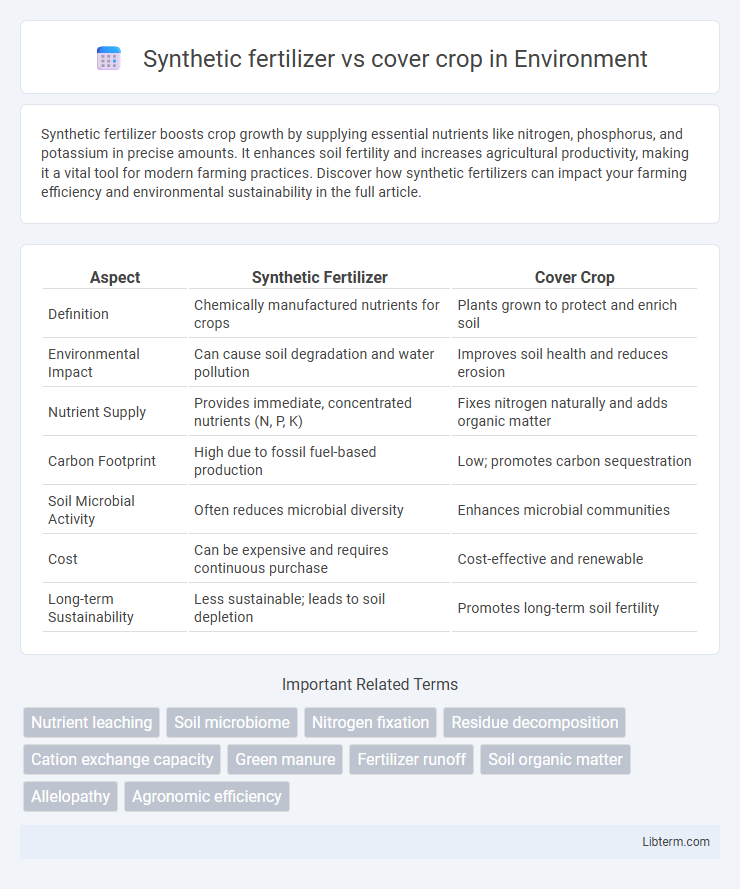Synthetic fertilizer boosts crop growth by supplying essential nutrients like nitrogen, phosphorus, and potassium in precise amounts. It enhances soil fertility and increases agricultural productivity, making it a vital tool for modern farming practices. Discover how synthetic fertilizers can impact your farming efficiency and environmental sustainability in the full article.
Table of Comparison
| Aspect | Synthetic Fertilizer | Cover Crop |
|---|---|---|
| Definition | Chemically manufactured nutrients for crops | Plants grown to protect and enrich soil |
| Environmental Impact | Can cause soil degradation and water pollution | Improves soil health and reduces erosion |
| Nutrient Supply | Provides immediate, concentrated nutrients (N, P, K) | Fixes nitrogen naturally and adds organic matter |
| Carbon Footprint | High due to fossil fuel-based production | Low; promotes carbon sequestration |
| Soil Microbial Activity | Often reduces microbial diversity | Enhances microbial communities |
| Cost | Can be expensive and requires continuous purchase | Cost-effective and renewable |
| Long-term Sustainability | Less sustainable; leads to soil depletion | Promotes long-term soil fertility |
Introduction to Synthetic Fertilizers and Cover Crops
Synthetic fertilizers are manufactured chemicals that supply essential nutrients like nitrogen, phosphorus, and potassium to enhance crop growth and boost agricultural productivity. Cover crops, such as legumes and grasses, are grown primarily to improve soil health by fixing nitrogen, preventing erosion, and increasing organic matter. Both approaches play crucial roles in modern agriculture, with synthetic fertilizers providing immediate nutrient availability and cover crops offering long-term soil sustainability benefits.
Definition and Types of Synthetic Fertilizers
Synthetic fertilizers are chemically manufactured substances designed to supply essential nutrients like nitrogen, phosphorus, and potassium to plants, enhancing crop growth and yield. Common types include nitrogen-based fertilizers such as ammonium nitrate, phosphorus-based fertilizers like superphosphate, and potassium-based fertilizers such as potassium chloride. Unlike cover crops, which naturally fix soil nutrients and improve structure, synthetic fertilizers provide immediate nutrient availability but may lack long-term soil health benefits.
Overview of Common Cover Crop Species
Common cover crop species such as clover, rye, and vetch play a crucial role in enhancing soil fertility by fixing nitrogen, improving soil structure, and preventing erosion, which contrasts with synthetic fertilizers that provide immediate nutrient inputs but may degrade soil health over time. Leguminous cover crops like crimson clover and hairy vetch efficiently fix atmospheric nitrogen, reducing the need for synthetic nitrogen fertilizers, while non-leguminous species such as cereal rye contribute organic matter and suppress weeds. Integrating these cover crops into crop rotations supports sustainable agriculture by maintaining nutrient cycling and promoting biodiversity, thereby reducing reliance on chemical fertilizers.
Nutrient Release and Soil Fertility Dynamics
Synthetic fertilizers provide immediate nutrient availability, primarily releasing nitrogen, phosphorus, and potassium in readily soluble forms, which supports rapid crop growth but can lead to nutrient leaching and reduced soil microbial activity. Cover crops enhance soil fertility dynamics by slowly releasing nutrients through organic matter decomposition, improving soil structure, increasing microbial biomass, and promoting nutrient cycling, thereby sustaining long-term soil health. The integration of cover crops with synthetic fertilizers can optimize nutrient release timing and improve overall soil fertility resilience.
Impacts on Soil Health and Microbial Activity
Synthetic fertilizers provide immediate nutrient availability but often lead to soil acidification, nutrient imbalances, and reduced microbial diversity, disrupting natural soil processes. Cover crops enhance soil health by improving organic matter content, promoting nitrogen fixation, and stimulating diverse microbial activity that supports nutrient cycling and soil structure. Long-term use of cover crops fosters resilient ecosystems and sustainable soil fertility, contrasting with synthetic fertilizers' potential to degrade soil microbial communities.
Environmental Effects: Runoff, Leaching, and Emissions
Synthetic fertilizers often contribute to nutrient runoff and leaching, leading to water pollution and eutrophication in aquatic ecosystems, while their production and application release greenhouse gases like nitrous oxide. Cover crops improve soil structure and nutrient retention, significantly reducing runoff and leaching by enhancing organic matter and microbial activity, which also helps sequester carbon and lower greenhouse gas emissions. Employing cover crops in agricultural systems mitigates environmental impacts by promoting nutrient cycling and reducing reliance on synthetic inputs.
Crop Yield and Productivity Comparisons
Synthetic fertilizers provide immediate nutrient availability, often resulting in higher short-term crop yields compared to cover crops. Cover crops improve soil health by increasing organic matter and nutrient cycling, enhancing long-term productivity and sustainability. Studies indicate that integrating cover crops with reduced synthetic fertilizer use can maintain yield levels while improving soil resilience and reducing input costs.
Economic Considerations for Farmers
Synthetic fertilizers offer immediate nutrient availability and predictable crop yields, which can enhance short-term economic returns for farmers. Cover crops improve soil health and reduce the need for expensive chemical inputs over time, potentially lowering long-term production costs and increasing sustainability. Investing in cover crops may incur initial costs and labor but can lead to improved soil structure, water retention, and resilience, contributing to better economic outcomes in future growing seasons.
Long-Term Sustainability and Resilience
Synthetic fertilizers provide immediate nutrient availability but often degrade soil health and reduce microbial diversity over time, compromising long-term sustainability. Cover crops enhance soil structure, increase organic matter, and promote microbial activity, leading to improved resilience against erosion, drought, and nutrient leaching. Integrating cover crops with reduced synthetic fertilizer application supports sustainable nutrient cycling and strengthens ecosystem stability for future agricultural productivity.
Choosing the Right Approach: Factors to Consider
Selecting between synthetic fertilizer and cover crops depends on factors such as soil health, crop type, and environmental impact. Synthetic fertilizers provide immediate nutrient availability, enhancing short-term yield, while cover crops improve soil structure, prevent erosion, and increase long-term fertility. Assessing budget constraints, sustainability goals, and regional climate conditions is essential for an informed nutrient management strategy.
Synthetic fertilizer Infographic

 libterm.com
libterm.com